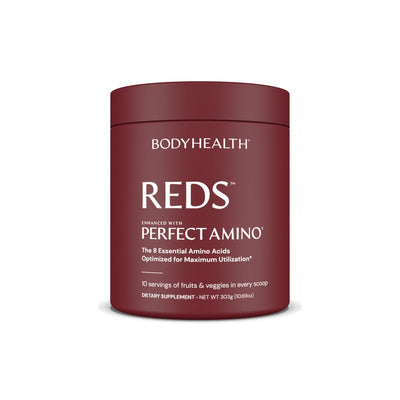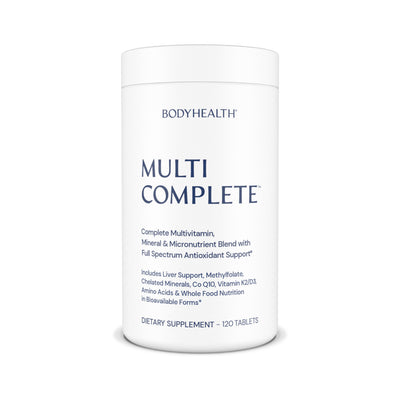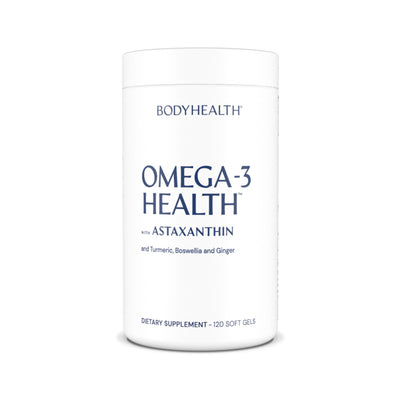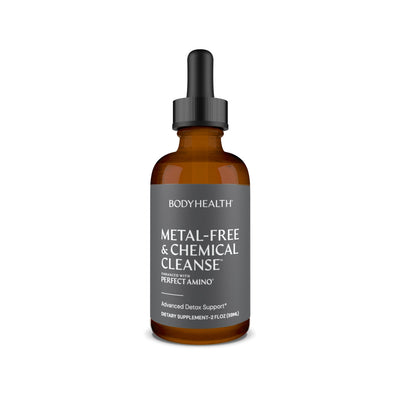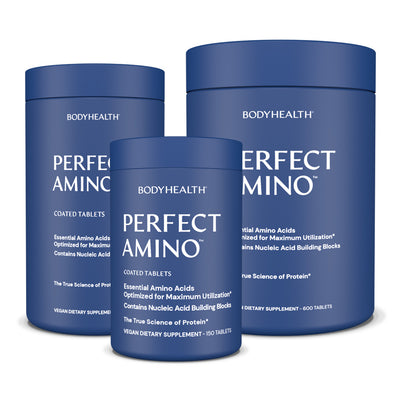Blood Flow For Muscle, Fat Loss & Overall Health
April 11, 2024 8 min read

When working out, blood flow is very important for both muscle building and fat loss.
It’s how the nutrients, water and oxygen needed for energy creation and muscle creation flow to our cells.
If our blood flow is lower, our cells do not get these nutrients or oxygen fast enough and our energy levels go down during high intensity workouts.
And it slows recovery.
Achieving healthy blood flow then is important for maximum results and maximum overall health.
In an earlier article we covered the truth about cholesterol and blood flow.
It covers the cholesterol hypothesis — and it is only that, a hypothesis (a proposed explanation made on the basis of limited evidence as a starting point for further investigation).
This hypothesis states that higher levels of cholesterol, particularly LDL Cholesterol, are associated with lowered heart health and blood flow.
And that to prevent this we must lower our cholesterol intake and lower our liver’s ability to produce cholesterol.
The thing is, there is no evidence to support the hypothesis.
In fact, the only studies we have on the matter not only refute it, but actually show that more often than not, the situation is the opposite.
Heart health among those 60 and above actually lowers as cholesterol is lowered, and raises as cholesterol levels are raised.
And, in a study of 12.8 million adults, it was found that those with the healthiest hearts and highest potential of survival, had cholesterol levels in the 200 to 240 levels, levels that have been considered very high.
In reality, cholesterol is necessary for our cells to operate and produce energy, and for the creation of key hormones.
You can learn more about what cholesterol actually is (a vital component of about a third of your hormones, and each one of your cells) in this article.
But, while the idea that consuming cholesterol causes trouble with blood flow may be a myth, the trouble itself can be quite real.
And the actual cause of it also affects our ability to build muscle, lose fat, keep high energy levels and overall health, keep our hormones in balance, and slow aging.
So let’s see what’s actually happening here and how we can help to raise our overall blood flow for healthy cells and a healthy heart, increase our ability build muscle, and raise our overall levels of energy and health.
OXYGENATING OUR CELLS: MUSCLE BUILDING & ENERGY LEVELS
We know we need oxygen to survive. But more specifically, our cells need oxygen to survive.
After about 5 minutes of low or no oxygen, cells begin to die.
This is because of something called ATP (Adenosine Triphosphate), the energy, or “food”, our cells live on.
ATP is made within the cell by combining oxygen with glucose (sugar), or ketones (from fat), or amino acids (from protein).
ATP is made by tiny organelles within the cell called mitochondria. There are about 1000-2500 mitochondria in each cell.
They take the oxygen and food source, and produce ATP which the cell then uses as energy to fuel itself.
And, as the cells are always working, they need a constant source of ATP to carry on.
So if we remove oxygen, they can’t make ATP, don’t have the fuel they need to work, and they die.
Or, if our oxygen levels are low, they produce less ATP, and have less energy.
And, so, as our bodies are nothing but cells, we have less energy.
But we also have less ability to repair cells or build new ones.
Your cells need energy to do this, and if energy levels are low, they conserve it for the most necessary of actions.
Cell turn-over rates decline. Cell replication, which is obviously needed for muscle building and replacing of old cells, declines.
So it becomes harder to build new muscle, our energy levels drop and, as our cells are not being replaced as often, we “age” as there are fewer new cells, even for our skin.
Obviously amino acids, fats and other nutrients are needed to produce new cells as well, but this point of oxygen is key, because it will slow things down faster than anything else.
And when working out or exercising, they need even more energy. More work is being given to them, our muscles are contracting faster and working harder. They need more ATP and more oxygen to do this.
So our breathing increases, to bring in more oxygen, and our heart rate increases to push oxygenated red blood cells through our bodies to the cells, where the oxygen is removed.
And this is where blood pressure comes in.
BLOOD FLOW, OXYGEN & FEELING OUT OF BREATH
When our cells need more oxygen to produce ATP, our breathing and heart rate increase, oxygen is transported to our cells by red blood cells, and they make ATP.
But these red blood cells have an exact size. They’re about 6-8 microns in diameter (a micron is 1/1000th of a millimeter).
White blood cells are even larger, about 30 microns.
And each cubic millimeter of blood contains about 4-6 million cells.
But the size of the blood vessels themselves can be smaller than the red blood cells.
Capillaries are the smallest blood vessels in the body, taking oxygenated red blood cells to each of our cells.
While they can be larger, the passage in most capillaries are about 3-4 microns in width, smaller than the blood cells that pass though them.
These red blood cells have to squish and elongate themselves to pass through these narrow passages. And they do so because of the pressure of the blood pushing them through.
That’s “blood pressure”.
But what happens when these capillaries become even more narrow?
What if they become 2 microns in width?
Then it’s harder for a blood cell to pass through them, so the heart has to beat harder, to raise blood pressure, to push them through.
Because they need to get through. Your cells will die without the oxygen they contain and your body is nothing but your cells.
If you’ve ever had a feeling of being out of breath, where you just can’t get enough air, you know what this is. It’s not that you’re not breathing enough, it's that your cells aren’t getting the oxygen they need fast enough.
If someone faints from over-exertion, this is their brain cells not getting oxygen fast enough.
But have you noticed that it’s easier for us to feel out of breath when running or working out, or even just walking, when we have more fat on our body?
This is because a good portion of the fat in our bodies isn’t just in our fat cells… but in our blood vessels, causing them to narrow.
BLOOD FLOW & CHOLESTEROL: WHAT’S ACTUALLY HAPPENING
I’m going to jump back to cholesterol for a moment here, not because cholesterol intake causes higher blood pressure, but because it does have a role. Just not what you think.
As covered in this article, when the inside walls of our blood vessels are injured, much like a scrape on the knee, our body puts a scab on it — a bandage.
If you scrape your knee, the scab is made, largely, of special blood cells called platelets, which clump together and dry out, forming the scab.
But inside your blood vessels, that “scab” or bandage is made of… cholesterol.
And that’s where the confusion comes from.
Because this isn’t a point of “you consume cholesterol and then that cholesterol goes and forms a scab.”
No.
Prior to this, there was an injury to the blood vessel itself caused by toxins, or high levels of sugar, or trans fats or harmful bacteria in your blood, and cholesterol was brought in to bandage that injury.
It has to be bandaged. It’s blood vessel.
But that’s where cholesterol comes in. It doesn’t, on its own, build up in our blood vessels, it’s sent to specific points in our blood vessels where an injury has occurred. An injury that was caused by something else.
It’s a reaction to the injury to help protect the blood vessel, not a cause of injury.
So the solution here isn’t to take away your body’s ability to bandage an injury, the solution is to remove the items that caused the injury which cholesterol was then needed to fix.
But this cholesterol does push out into the inside passage of the blood vessel and take up space, narrowing the passageway for blood cells to get through.
So our heart needs to raise blood pressure to push the blood cells through to get oxygen to our cells.
IMPROVING BLOOD FLOW
There are a few things that can significantly help blood flow.
The first is broccoli sprouts. These actually help to repair damage done to the blood vessels themselves that cholesterol is used to bandage.
They are fantastic for overall cardiovascular health.
Then there is Reds. This contains key ingredients that both help to protect blood vessel walls, but also increase blood flow to ensure our cells and heart get the nutrients and oxygen they need for optimal health and function.
And electrolytes also play a key role in the actual pumping action of the heart, as it is specific nerves that control this and they require electrolytes to function at proper levels.
Then there is Omega 3 Fatty Acids.
We already know that these help to maintain proper cortisol levels, high amounts of which can cause injury to our blood vessels.
But they also help our cells to be “squishier,” which is important here.
Many of our blood vessels are very, very small. This is especially the case for those that bring nutrients through to the cells in our muscles which are responsible for the creation of new muscle cells.
These blood vessels are actually smaller than the blood cells that pass through them, which must squish and elongate to make it through.
Omega 3 helps make these blood cells squishier, so they have an easier time passing through, thus improving blood flow.
The last thing is Vitamin E. This is an amazing vitamin and through its overall function it helps to increase oxygenation of the cells.
I would highly urge you to make sure it’s in your vitamins. Our Multi Complete contains 400mg of vitamin E per serving.
And, of course, work to increase your VO2 Max, as this will help improve blood flow and your cell’s ability to take in oxygen and increase energy levels for performance, endurance and recovery.
I hope this helps.
If you haven’t seen the Lean Body/Lean Bulk Program, check it out and do the 30-Day Challenge. It’s very effective.
And make sure to join our VIP Group where you can ask any question you have and get only the best answers.
Index To The Lean Body/Lean Bulk Guide:
Introductory Articles:
Getting Started:
- The Lean Body/Lean Bulk Guide & 30-Day Challenge
- Hormones: The Third Dimension of Calorie Cutting
- The Lean Body/Lean Bulk Diet
Supplements & Macros By Goal:
- Supplements & Macros For Lean Body
- Supplements & Macros For Beginner To Moderate Lean Bulking
- Supplements & Macros For Advanced Lean Bulking
Workout Regimens & Exercise Videos:
- Beginner to Moderate Level Workout Regimen
- Advanced Workout Regimen
- Lean Body/Lean Bulk Exercise Videos
Week One:
- Metrics & Key Data For Week One
- How BCAAs Build Body Fat & Lower Health Over Time
- The Importance Of Complete Protein Digestion
Week Two:
- Dialing In Our Macros For Lean Muscle: Hormones & Cravings
- How Cortisol Breaks Down Muscle & Prevents Protein Synthesis
- How To Improve Growth Hormone, Testosterone & Protein Synthesis
Week Three:
- Thyroid, Estrogen & Progesterone: Speeding Fat Loss & Lean Muscle Creation
- Improving Sleep: Muscle Building, Fat Loss, Mood & Aging
- Maximizing Cellular Function For Endurance & Recovery
Week Four:
- Raising VO2 Max: Endurance, Performance & Recovery
- How Toxins Affect Our Hormones: Building Muscle & Fat Loss
- Blood Flow For Muscle, Fat Loss & Overall Health
Final Week:
Articles by Health Topic
Your Path To Better Health Starts Here!
From in-depth articles on nutritional benefits to updates on new product launches, stay informed and inspired on your journey to optimal health.
*These statements have not been evaluated by the Food and Drug Administration. These products are not intended to diagnose, treat, cure, or prevent any disease.
